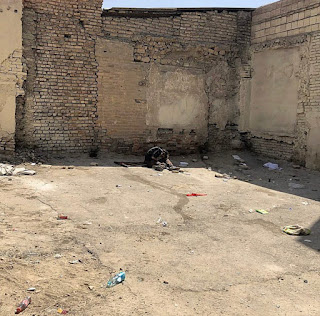Walking within a Canvas
 |
| Serpentine Pavilion 2015, designed by Selgascano. All photos by Mahsa Alami |
Walking within a Canvas: Serpentine Pavilion 2015
Mahsa Alami
It is just about colors; an iridescent jelly
object eventually catches the eyes while passing through the pathways of
‘Kensington Gardens’. A translucent object which you can easily recognise the
shadows of ‘bodies of walkers’ within it. An empty colorful mass with irregular
artistic steel frames which has been overlapped partially with joyful colored ribbons
is open to public as the 15th series of annual Serpentine Gallery’s
temporary pavilion.
 |
| A translucent object |
While the inner membrane is too light because
of these balloon-shaped walls, it is expected to levitate easily but the steel
frames hold them up and twitch them to the immovable white platform. This
secured white platform is holding these fragile combinations of layers and
ribbons which are about to fly. In a sunny day, rays of light filtered through
the colorful plastics and ribbons, reflecting the shapes and colors on the
white platform. It makes a fantastic exhibition of light and colors which holds
a thoughtful architectural effort in its background. It becomes a piece of art,
a beautiful painting in which the sun brings the colors and it contours them on
the white canvas, where you are walking within it. It is just about colors. Regardless
of nonharmonic and accidentally movement of ribbons, from the architectural point
of view, the reflection of these movements in combination with the harmonic
attitude of steel frames creates an aesthetic painting on the canvas.
Seemingly, it was the main target of designers to build a conjugation of colors
glowing, shadows, reflections, brightness, airy atmosphere, playful rhythm of movements,
happy hour of hanging out and above all, offering different views of surrounding
gardens from within pavilion’s festival
of colors.
On the other side of the coin, the unsuccessful
engineering of functional details shows first of all, how the construction of
the whole pavilion is inoperative due to patching the ribbons and frames
together with tape in some parts and also because of rain leaking from almost
everywhere in the rainy days which cause water splash within the floor as if
there is no proper border between landscape and the stage (which supposedly was
a target of designer to send this message that there is no absolute way of
space division in architecture). Secondly, as the result of inaccurate
finishing, the pavilion seems to be vulnerable for it could not preserve its
appearance during its 6 month of existence just as it can be seen some
considerable damages has been accrued due to becoming a translucent bondage
cave for children’s hide-and-seek which led some ribbons become loose. Even
worse, parts of the floor has been cracked while representing the beneath layer
of concrete which is neither artistic nor architectural.
 |
Ribbons has
been taped to frames
|
In total, it seems this translucent object
embraces the meaning of uncertainty in terms of its unpredictable geometry and
imprecise manipulated structure. The idea of using handy materials in an
unstable way of construction for a public space is questionable. Materials such
as ribbons which have been threaded accidentally into the steel frames could
have been more protected to not being damaged. Translucent plastics as the
major feature of the pavilion must have had a thoughtful overlapping. Also the
resistless and fragile floor finishing which is the main reason why this
floated object has still stuck to the ground could have been implemented more
appropriately. If this pavilion has a thoughtful design based on deconstructivism,
which is obvious from its formal and geometrical expression, then why its
construction lacks accuracy and precision? Perhaps, a more constructive
collaboration between architects and builders could let the pavilion remain fresh
like its very early days of opening to public.
 |
Inappropriate
floor finishing
|


Comments
Post a Comment